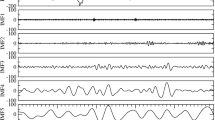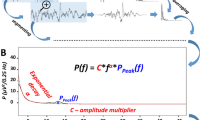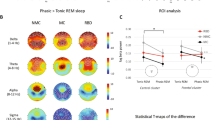Abstract
To investigate the effect on the sleep EEG, a 1-mg oral dose of SR 46349B, a novel 5-HT2 antagonist, was administered three hours before bedtime. The drug enhanced slow wave sleep (SWS) and reduced stage 2 without affecting subjective sleep quality. In nonREM sleep (NREMS) EEG slow-wave activity (SWA; power within 0.75–4.5 Hz) was increased and spindle frequency activity (SFA; power within 12.25–15 Hz) was decreased. The relative NREMS power spectrum showed a bimodal pattern with the main peak at 1.5 Hz and a secondary peak at 6 Hz. A regional analysis based on bipolar derivations along the antero-posterior axis revealed significant ‘treatment’ × ‘derivation’ interactions within the 9–16 Hz range. In enhancing SWA and attenuating SFA, the 5-HT2 receptor antagonist mimicked the effect of sleep deprivation, whereas the pattern of the NREMS spectrum differed.
Similar content being viewed by others
Log in or create a free account to read this content
Gain free access to this article, as well as selected content from this journal and more on nature.com
or
References
Adrien J . (1995): The serotoninergic system and sleep-wakefulness regulation. In Kales A (ed), The Pharmacology of Sleep. New York, Springer, pp 91–116
Aeschbach D, Cajochen C, Landolt HP, Borbély AA . (1996): Homeostatic sleep regulation in habitual short and long sleepers. Am J Physiol 270: R41–R53
Ashby CR Jr, Edwards E, Wang RY . (1994): Electrophysiological evidence for a functional interaction between 5-HT1A and 5-HT2A receptors in the rat medial prefrontal cortex: An iontophoretic study. Synapse 17: 173–181
Bobker DH . (1994): A slow excitatory postsynaptic potential mediated by 5-HT2 receptors in nucleus prepositus hypoglossi. J Neurosci 14: 2428–2434
Borbély AA, Baumann F, Brandeis D, Strauch I, Lehmann D . (1981): Sleep deprivation: Effect on sleep stages and EEG power density in man. Electroenceph Clin Neurophysiol 51: 483–493
Borbély AA, Tobler I, Hanagasioglu M . (1984): Effect of sleep deprivation on sleep and EEG power spectra in the rat. Behav Brain Res 14: 171–182
Borbély AA, Tononi G . (1998): The quest for the essence of sleep. Daedalus. Proc Am Acad Arts Sci 127: 167–196
Borbély AA, Trachsel L, Tobler I . (1988): Effect of ritanserin on sleep stages and sleep EEG in the rat. Eur J Pharmacol 156: 275–278
Declerck AC, Wauquier A, Van der Ham-Veltman PHM, Gelders Y . (1987): Increase in slow-wave sleep in humans with the serotonin-S2 antagonist ritanserin. The first exploratory polygraphic sleep study. Curr Ther Res Clin Exp 41: 427–432
Dijk DJ, Beersma DGM, Daan S, van den Hoofdakker RH . (1989): Effects of seganserin, a 5-HT2 antagonist, and temazepam on human sleep stages and EEG power spectra. Eur J Pharmacol 171: 207–218
Dijk DJ, Brunner DP, Borbély AA . (1990): Time course of EEG power density during long sleep in humans. Am J Physiol 258: R650–R661
Dijk DJ, Hayes B, Czeisler CA . (1993): Dynamics of electroencephalographic sleep spindles and slow wave activity in men: Effect of sleep deprivation. Brain Res 626: 190–199
Driver HS, Flanigan MJ, Bentley AJ, Luus HG, Shapiro CM, Mitchell D . (1995): The influence of ipsapirone, a 5-HT1A agonist, on sleep patterns of healthy subjects. Psychopharmacology 117: 186–192
Feinberg I, Floyd TC . (1979): Systematic trends across the night in human sleep cycles. Psychophysiology 16: 283–291
Gillin JC, Jernajczyk W, Valladares-Neto D, Golshan S, Lardon M, Stahl SM . (1994): Inhibition of REMS by ipsapirone, a 5-HT1A agonist, in normal volunteers. Psychopharmacology 116: 433–436
Gillin JC, Sohn JW, Stahl SM, Lardon M, Kelsoe J, Rapaport M, Ruiz C, Golshan S . (1996): Ipsapirone, a 5-HT1A agonist, suppresses REMS equally in unmedicated depressed patients and normal controls. Neuropsychopharmacology 15: 109–115
Hoyer D, Martin GR . (1996): Classification and nomenclature of 5-HT receptors: A comment on current issues. Behav Brain Res 73: 263–268
Humphrey PPA, Hartig P, Hoyer D . (1993): A proposed new nomenclature for 5-HT receptors. Trends Pharmacol Sci 14: 233–236
Idzikowski C, Mills FJ, Glennard R . (1986): 5-Hydroxytryptamine-2 antagonist increases human slow wave sleep. Brain Res 378: 164–168
Jouvet M . (1972): The role of monoamines and acetylcholine-containing neurons in the regulation of the sleep-waking cycle. Ergebn Physiol 64: 166–307
Lesch KP, Poten B, Söhnle K, Schulte HM . (1990): Pharmacology of the hypothermic response to 5-HT1A receptor activation in humans. Eur J Clin Pharmacol 39: 17–19
McCormick DA . (1992): Neurotransmitter actions in the thalamus and cerebral cortex and their role in neuromodulation of thalamocortical activity. Prog Neurobiol 39: 337–388
McCormick DA, Bal T . (1997): Sleep and arousal: Thalamocortical mechanisms. Annu Rev Neurosci 20: 185–215
McCormick DA, Wang Z . (1991): Serotonin and noradrenaline excite GABAergic neurons of the guinea pig and cat nucleus reticularis thalami. J Physiol 442: 235–255
Pazos A, Probst A, Palacios JM . (1987): Serotonin receptors in the human brain. IV. Autoradiographic mapping of serotonin-2 receptors. Neuroscience 21: 123–239
Portas CM, Bjorvatn B, Fagerland S, Grønli S, Mundal V, Sørensen E, Ursin R . (1998): On-line detection of extracellular levels of serotonin in dorsal raphe nucleus and frontal cortex over the sleep/wake cycle in the freely moving rat. Neuroscience 83: 807–814
Rechtschaffen A, Kales A . (eds) (1968):A Manual of Standardized Terminology, Techniques and Scoring System for Sleep Stages of Human Sleep. Washington, D.C.: Public Health Service, U.S. Government Printing Office
Rinaldi-Carmona M, Cogny C, Santucci V, Simiand J, Gautret B, Neliat G, Labeeuw B, Le Fur G, Soubrie P, Breliere JC . (1992): Biochemical and pharmacological properties of SR 46349B, a new potent and selective 5-hydroxytryptamine2 receptor antagonist. J Pharmacol Exp Ther 262: 759–768
Saucier C, Morris SJ, Albert PR . (1998): Endogenous serotonin-2A and -2C receptors in Balb/c-3T3 cells revealed in serotonin-free medium: Desensitization and down-regulation by serotonin. Biochem Pharmacol 56: 1347–1357
Schwartz PJ, Wehr TA, Rosenthal NE, Bartko JJ, Oren DA, Luetke C, Murphy DL . (1995): Serotonin and thermoregulation: Physiologic and pharmacologic aspects of control revealed by intravenous m-CPP in normal human subjects. Neuropsychopharmacology 13: 105–115
Seifritz E, Moore P, Trachsel L, Bhatti T, Stahl SM, Gillin JC . (1996): The 5-HT1A agonist ipsapirone enhances EEG slow wave activity in human sleep and produces a power spectrum similar to 5-HT2 blockade. Neurosci Lett 209: 41–44
Sharpley AL, Elliott JM, Attenburrow M-J, Cowen PJ . (1994): Slow wave sleep in humans: Role of 5-HT2A and 5-HT2C receptors. Neuropharmacology 33: 467–471
Steriade M, Contreras D, Amzica F . (1994): Synchronized sleep oscillations and their paroxysmal developments. Trends Neurosci 17: 199–208
Steriade M, McCormick DA, Sejnowski TJ . (1993): Thalamocortical oscillations in the sleeping and aroused brain. Science 262: 679–685
Tissier MH, Lainey E, Fattaccini CM, Hamon M, Adrien J . (1993): Effects of ipsapirone, a 5-HT1A agonist, on sleep/wakefulness cycles: Probable post-synaptic action. J Sleep Res 2: 103–109
Tobler I, Borbély AA . (1990): The effect of 3-h and 6-h sleep deprivation on sleep and EEG spectra of the rat. Behav Brain Res 36: 73–78
Werth E, Achermann P, Borbély AA . (1997): Fronto-occipital EEG power gradients in human sleep. J Sleep Res 6: 102–112
Werth E, Achermann P, Borbély AA . (1998): Regional differences in the sleep EEG: Functional implications. Sleep 21(suppl):207
Werth E, Dijk DJ, Achermann P, Borbély AA . (1996): Dynamics of the sleep EEG after an early evening nap: Experimental data and simulations. Am J Physiol 271: R501–R510
Acknowledgements
We thank Dr. Corinne Roth for her assistance with the experiment and Dr. Irene Tobler for comments on the manuscript. This research was supported by SANOFI Recherche, the Swiss National Science Foundation (Grant Nr. 3100–042500.94 and 3100–053005.97) and the Human Frontiers Science Program RG 81/96.
Author information
Authors and Affiliations
Rights and permissions
About this article
Cite this article
Landolt, HP., Meier, V., Burgess, H. et al. Serotonin-2 Receptors and Human Sleep: Effect of a Selective Antagonist on EEG Power Spectra. Neuropsychopharmacol 21, 455–466 (1999). https://doi.org/10.1016/S0893-133X(99)00052-4
Received:
Revised:
Accepted:
Issue date:
DOI: https://doi.org/10.1016/S0893-133X(99)00052-4
Keywords
This article is cited by
-
An examination of sleep spindle metrics in the Sleep Heart Health Study: superiority of automated spindle detection over total sigma power in assessing age-related spindle decline
BMC Neurology (2023)
-
Genetic endophenotypes for insomnia of major depressive disorder and treatment-induced insomnia
Journal of Neural Transmission (2019)
-
Sleep as a Therapeutic Target in the Aging Brain
Neurotherapeutics (2019)
-
Selective Serotonin 5-HT2A Receptor Antagonists and Inverse Agonists Specifically Promote Slow Wave Sleep (Stage N3) in Man
Sleep and Vigilance (2017)
-
Differential regulation of observational fear and neural oscillations by serotonin and dopamine in the mouse anterior cingulate cortex
Psychopharmacology (2014)



